Blokzijl is the cradle of our family tree. The Ruiter family lived in or nearby Blokzijl for a number of centuries.
So, this little history of Blokzijl gives background to the lives of our distant ancestors.
I have used several books , among them Langs de diek by Lute Bouwer (Meppel, 2005)
|
lokzijl is mentioned for the first time in 1524 when the Governer of Vollenhove complained that soldiers have sacked Bluxiel and Blankenham. And in 1561 we learn that Blokzijl as receiver of the toll has been given the right by the (Spanish) king Philips II to mount the royal arms above the door of the toll house. But of course, the settlement was much older than the 16th century. In 1363 there is mention of 'den groeten zijl ende dat zijldiep' (the big lock and the lock-chamber).
We don't now exactly when Blokzijl came into existence, but the circumstances under which it originated are somewhat known. On the location where the river Steenwijker Aa flows into the Zuiderzee, a lock had to be built to prevent the flood waters from flooding the land behind the dike. This lock (zijl) was called the
Vollenhoofse zijl (lock of Vollenhoven) - it was built and paid for by the city of Vollenhove. The river Aa connected the city of Steenwijk to the sea and was very important to this city. So it was Steenwijk that build a second lock, a little to the north of the Vollenhoofse Zijl, in a new water way, the Noorderdiep. This new lock was called the
Steenwijker Zijl (the lock of Steenwijk). Already in 1438 Steenwijk was rebuilding the lock near Blockes house, the first clue of the name Blokzijl. The names Steenwijker Kolk (Steenwijk Chamber) and Steenwijkerzeedijk (Steenwijk Seadike) indicate the influence of Steenwijk in this area.
The area between both locks was built up, as this map from 1570 shows :
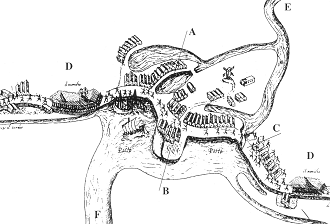
A : old lock
C : new lock
E : Noorderdiep
F : access to the Zuiderzee
Late in the 16th century there were some new developments that were to have a great impact on Blokzijl. There was increasing demand for peat bricks, for heating houses in the large Dutch cities, and the shipping of all those peat bricks was for the most part via Blokzijl. The toll-house near the locks was a major source of income because of all
the ships that had to use the lock. The conflict began between Spain and the Dutch was of major importance too. The cities of Holland had declared independence from Spain, and Blokzijl was sympathetic to this, but the surrounding area was still under Spanish control. It was of the greatest importance to Holland to protect the shipment of peat bricks
from Overijssel. So in the years 1580-1590 the settlement of Blokzijl was transformed into a real fortress under command of
Diederick van Sonoy. The city was fortified and surrounded with walls and canals. Prince Maurits granted Blokzijl a large number of rights, by-passing the States of Overijssel. Next to the trading of peat bricks, also Beer Breweries were economically important. One time there were some five Breweries within the city walls, they even had their own guild.
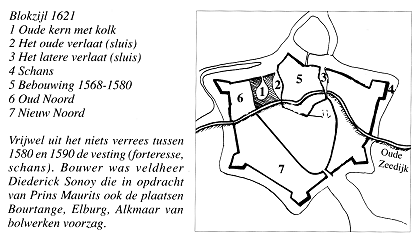
In these years only the area around the old lock (Steenwijker Zijl), the area to the west of the Steenwijker Kolk and the area between the old lock and the Vollenhoofse Zijl, the so-called Wortelmarkt, was built up. Blokzijl was prosperous and continued to grow. There was intense trade with the Dutch cities of Hoorn and Enkhuizen and there is ample reason
to think of Blokzijl as a Dutch colonial city on Overijssel soil (and in Spanish territory).
The houses that were built in this period show all the marks and features of the houses built on the other side of the Zuiderzee. Along the quays of Blokzijl these houses still stand.
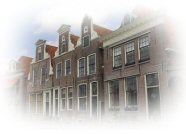
The ending of the Golden Age does not go unnoticed to Blokzijl. There is a continuing problem with the silt build-up of the harbour. Costly measures had to be taken - the harbour was dredged a number of times and long piers were constructed to make an entrance to the harbour. For Blokzijl the golden years were between 1623 and 1666. At the peak, more than 160
karvelen (sea-going trading ships) took residence in Blokzijl's harbour.
The year 1666 was a major crisis - England destroyed the major part of our trading fleet in the Zuiderzee and our country never recuperated.
The next map shows the street patterns of Blokzijl. The old build-up area can be found under numbers 4, 5 and 6. It should be noticed that the Groenestraat (Greenstreet) was formerly known as the Schipperstraat (Boatmanstreet). The name of Groenestraat has to do with the whalers, who were called Groenlandvaarders - (Greenlandshipping).
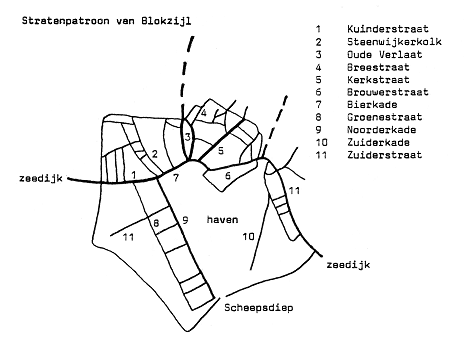
Another important year is 1672, in Holland known as the disaster year, when our country was invaded by France, England, Cologne and Munster.
The army of the Bishop of Munster occupied Blokzijl and plundered the city. A Frisian army came to the rescue and liberated Blokzijl. The inhabitants of Blokzijl showed their most valiant side and made their city the first liberated city of Holland. Prince Willem II was so pleased with this that he granted several rights to the city again. Blokzijl now had official city rights, but the Governor of Vollenhove and the States of Overijssel did not give in and after three years of political bickering they were successful in that Blokzijl lost her rights again. But Blokzijl was unmoved and continued to act as a city.
The dependency on the peat bricks came painfully to light when the peat digging in Overijssel started to decline. Along with the income the economic activity recessed also. In the year 1700 Blokzijl had only 40 ships left.
In the year 1709 both wooden locks were in desperate need of repair and it was decided to build a single stone lock where the Vollenhoofse Zijl was before. The current lock was built in line with this lock of 1709, using that lock as foundation for the bridge.
In the late 18th century there was some recovery, but the former wealth did not return. Slowly the industries in Blokzijl became more important : the saw-mill, the salt-works, the limekiln, the tannery and the mat-makers. The salt-works and limekiln disappeared as the 18th
century wore on and the last large industry, the saw-mill closed down in the early thirties of the 20th century.
In the 19th century the mat-trading blossomed. These mats were home-made in Blokzijl and surrouding villages, and were shipped to the cities in Noord- and Zuid-Holland.
Around 1900 this trading also stopped.
And then the Afsluitdijk (the dike that closed off the Zuiderzee and made this former sea into the IJsselmeer) and the Noordoostpolder (a large land-reclaiming site which made Blokzijl lose easy access to the sea) had a monumental influence on Blokzijl. All shipping and trading came almost to a standstill. Now, 75 years later, there is a business-park employing around 100 people and in the summertime tourism is a major source of income. The locks of Blokzijl are still very busy during the summer months to dock all the yachts and sailing boats on their way to and from Friesland.
In the history of Blokzijl a number of communities played a major role.
In the first place there existed a group of local inhabitants - perhaps many coming from Steenwijk or Steenwijkerwold.
From 1585 through 1610 there was a major influx of Flemish into Dutch cities in Holland, especially Amsterdam. These people were fleeing the Spanish Inquisition, when anybody that wasn't considered Catholic (enough) had to fear for his life. Amsterdam alone saw its population grow with more than 20,000 new inhabitants!
The re-making of Blokzijl into a fortress in the 1580-1590 period increased the city population with a considerable number of soldiers that were needed to man the walls. The majority of these soldiers came from Holland (from what we call today Westfriesland - the area north of Amsterdam around Enkhuizen and Hoorn).
Further revival of trade caused large numbers of traders and boatmen to move into Blokzijl, also the majority coming from Holland (Amsterdam, Hoorn, Enkhuizen).
Most of Blokzijl's population was, as it was then known, Nederduits Hervormd. (Dutch Reformed).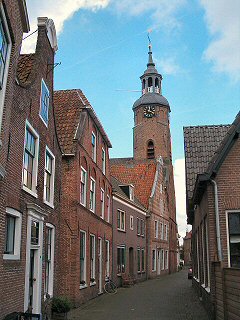 In 1608 the construction of a church for the benefit of this community started. In the Netherlands this was to be the first church built destined for other than Catholic worship. In 1608 the construction of a church for the benefit of this community started. In the Netherlands this was to be the first church built destined for other than Catholic worship.
In 1613 the church was finished in its first form. This building was a simple hall-church and was soon considered too small.
During this period Blokzijl was experiencing enormous growth and soon a number of expansions in 1643 (southwall) and 1650 (westwall) and in 1662 the eastwall took place. After this last extension the church had the form of a Greek cross.
There are a number of things inside the church that attract special attention :
- The large leaded glass window of 1662, a gift from the city of Zwolle to commemorate the valiant stand of Blokzijl during the 80-year war between Spain and Holland.
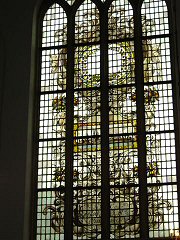
- The ship model of 1677. Originally there used to be a model made of silver, but that was taken away by the soldiers of the Bisshop of Munster while they occupied Blokzijl for a number of months. This model of 1677 was a gift from the Shipping Guild.
- The five large chandeliers, all from the 17th century. The largest chandelier is another gift from the Shipping Guild and dates from 1640.
- The pulpit from 1663 with a sand-glass that was turned at the start of the sermon to 'remind the preacher that the patience of the listeners has its limits'.
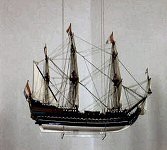
- The baptismal font is a gift of the Tailor Guild and is also from 1663.
The church was extensivily renovated in the period 1995-1999 and many original elements have been restored.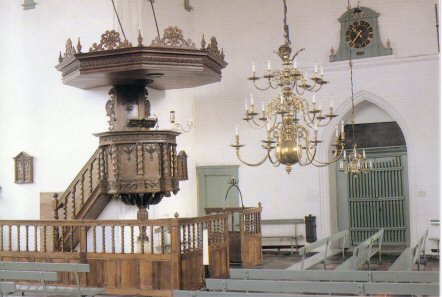
|